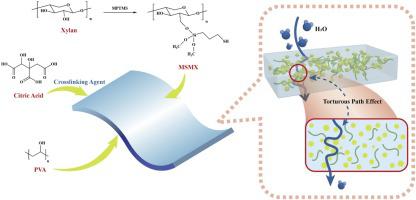Industrial Crops and Products ( IF 5.9 ) Pub Date : 2021-07-24 , DOI: 10.1016/j.indcrop.2021.113822 Yining Wang 1 , Xin Guo 1 , Jinhui Li 1 , Wenqian Jia 1 , Fang Qian 2 , Haisong Wang 1 , Yanna Lv 1, 3

|
The application of polysaccharide-based films is limited due to core problems, such as poor water vapor barriers and flexibility. From this perspective, silane coupling agents have recently attracted particular interest because of their insensitivity to moisture. However, it may cause poor mechanical properties due to the aggregation of silane coupling agents within the materials. Here, we report a collaborative modification protocol to reduce water vapor transmission capacity and to improve the flexibility of xylan-based films. Xylan from sugarcane bagasse was firstly modified with (3-mercaptopropyl) trimethoxysilane (MPTMS) to obtain MPTMS-modified xylan (MSMX), and then blended with polyvinyl alcohol (PVA) using citric acid (CA) as a cross-linker. The PVA/MSMX/CA films were found to be highly impermeable to water vapor and to have robust solvent resistance. With an optimized mass ratio (PVA/MSMX, 2:1), the water vapor permeability (WVP) value was 2.79 × 10−13 (g/cm−1·s ∙Pa), significantly lower than that of previously reported PVA/xylan-based films. The excellent barrier properties were attributed to the “torturous path effect”. Meanwhile, the elongation at break increased up to 480 %, showing a 2-fold enhancement compared to that of PVA/xylan films. This study revealed a great potential of using the PVA/MSMX/CA films as packaging materials for moisture susceptible drugs, food, and electronic components.
中文翻译:

(3-巯基丙基)三甲氧基硅烷与柠檬酸协同提高聚乙烯醇/木聚糖包装膜水蒸气阻隔性能
由于水蒸气阻隔性差和柔韧性差等核心问题,多糖基薄膜的应用受到限制。从这个角度来看,硅烷偶联剂最近引起了特别的兴趣,因为它们对水分不敏感。然而,由于硅烷偶联剂在材料内的聚集,它可能导致较差的机械性能。在这里,我们报告了一种协作修改协议,以降低水蒸气传输能力并提高基于木聚糖的薄膜的灵活性。甘蔗渣中的木聚糖首先用(3-巯基丙基)三甲氧基硅烷(MPTMS)改性得到 MPTMS 改性的木聚糖(MSMX),然后以柠檬酸(CA)为交联剂与聚乙烯醇(PVA)共混。发现 PVA/MSMX/CA 薄膜高度不透水蒸气并具有强大的耐溶剂性。优化质量比 (PVA/MSMX, 2:1),水蒸气渗透率 (WVP) 值为 2.79 × 10-13 (g/cm -1 ·s ∙Pa),明显低于先前报道的基于 PVA/木聚糖的薄膜。优异的阻隔性能归因于“曲折路径效应”。同时,断裂伸长率增加了 480%,与 PVA/木聚糖薄膜相比,提高了 2 倍。这项研究揭示了使用 PVA/MSMX/CA 薄膜作为潮湿敏感药物、食品和电子元件包装材料的巨大潜力。


























 京公网安备 11010802027423号
京公网安备 11010802027423号